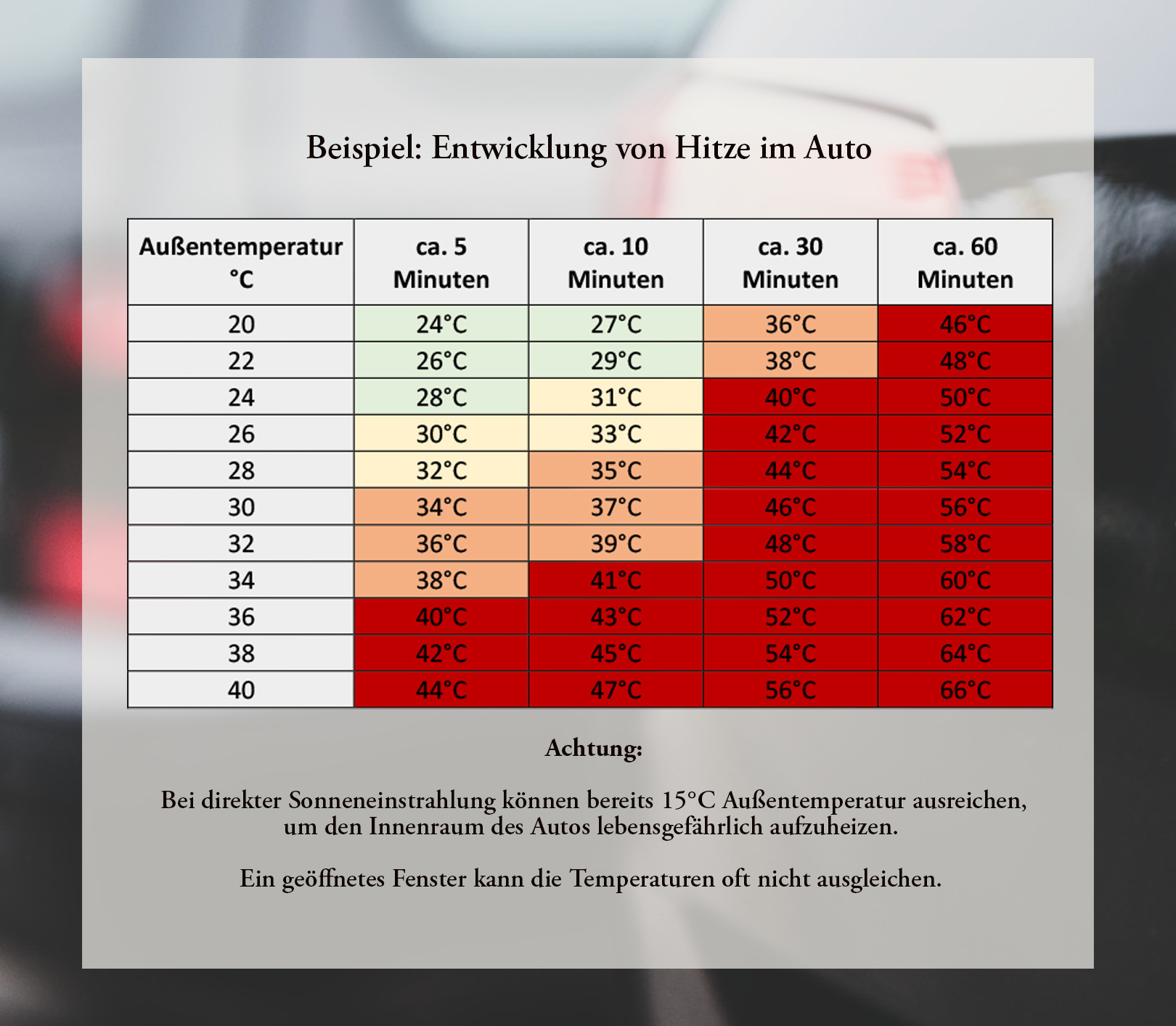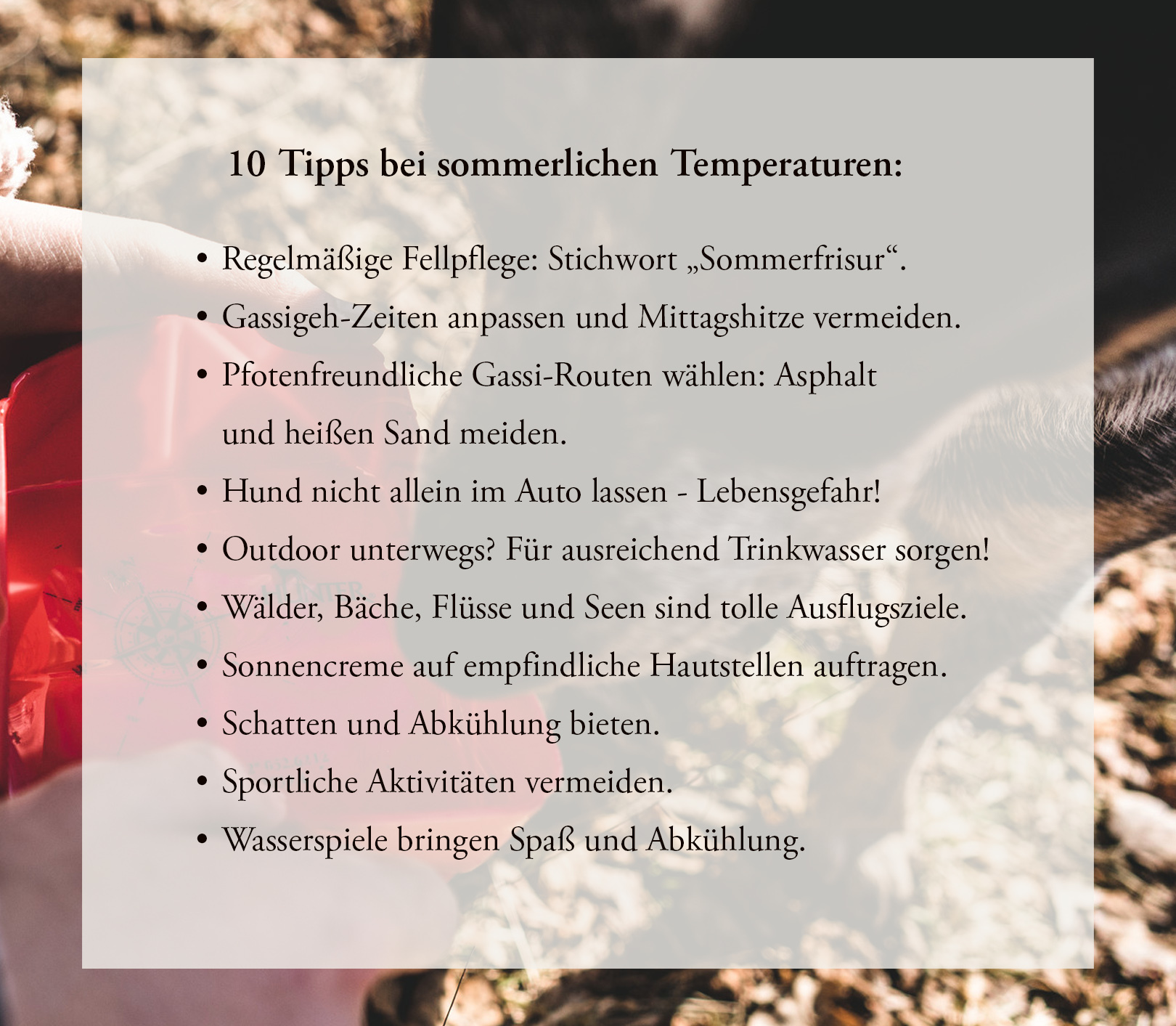Dog and heat: 4 common dangers
Summer is the time for long walks, picknicks by the lake and cozy hours in the garden at home. Dogs also like to bathe in the sun and enjoy the warmth on their fur. However, if it gets too hot, they instinctively look for a shady spot. But be careful: at very high temperatures, it can quickly become too warm for your darling even in the shade, as he has sweat cells exclusively under his paws and cannot sweat. Now it's up to you to act! We explain the 4 most common dangers for overheating in your dog and explain how you can recognize symptoms and act correctly.
Danger 1: Special dog breeds
Dogs have different coat structures and body characteristics depending on the breed. Some cause dogs to have trouble regulating their body temperature. These include:
- Dog breeds with particularly dense, long fur and undercoat, such as the Golden Retriever, German Shepherd or Bernese Mountain Dog. Due to the dense coat, the heat is stored longer on the skin.
- Dog breeds with brachycephaly, i.e. short muzzles and flat faces, such as pugs, boxers and French bulldogs. Dogs with particularly flat faces tend to breathe through the mouth and have to pant much more because breathing through the nose is more difficult. The reduced oxygen circulation may lead to circulatory problems and exhaustion more quickly.
- Breeds with particularly thin hair, without undercoat, such as Yorkshire Terrier, Miniature Schnauzer and Poodle. The light hair structure of the popular allergy dogs does not provide the skin with sufficient protection from sunlight, which can lead to a painful sunburn.
Our tip: Regular brushing and trimming helps dogs with thick coats to avoid overheating on hot summer days. How the coat care succeeds and what tools you need as a dog owner, you will learn in our article "Dog trim: How to trim your dog's hair".
Danger 2: Old or immunocompromised dogs in summer
Since seniors have a slower metabolism, they find it increasingly difficult to regulate their own body temperature. Even immunocompromised dogs suffering from a metabolic disorder, a chronic disease (e.g. Lyme disease) or obesity quickly reach their physical limits due to the summer heat. If the body temperature in healthy dogs exceeds the critical value of 41° Celsius, the organs begin to stop functioning in the course of heat exhaustion. In old and immunocompromised dogs, this process begins much earlier and, in the worst case, becomes life-threatening.
Our tip: Avoid exertion and physical strain and take the temperature of your four-legged friend regularly during a longer stay in the sun. In case of deviations above the normal value up to 39.5° Celsius, bring your dog indoors for a while to cool down. Further measures to cool down your dog can be found in the section "Cooling down your dog: 3 first aid measures".

Danger 3: Dog paws on hot surfaces
Especially in the afternoon sun, asphalt and sidewalk slabs heat up quickly. But even in the late afternoon and evening hours, the stored heat should not be underestimated: At an outside temperature of about 25° Celsius, the streets and paths can still reach ground temperatures above 50° Celsius. If your dog is walking numbly and is no longer putting weight on individual paws, he has probably suffered burns.
You can recognize mild burns by the following characteristics:
- swollen bales
- reddened skin areas
In case of mild symptoms, the affected paws should be cooled immediately. Ointment and socks as a bandage will help to protect the paws in the next few days.
You can recognize bad burns by these symptoms:
- Burn blisters
- open, sore bales
- charred areas
If the burn is severe, see a veterinarian immediately to have the wounds dressed and bandaged.
Our tip: If you are unsure whether the floor is too hot for a walk with your four-legged friend, try the seven-second test. Here you press your backhand on the floor covering. If you can do this for seven seconds without feeling any pain, you can walk your pet without worry.
Danger 4: Dogs in hot cars
Not every dog owner has the fields and wooded areas right outside the front door. Therefore, in order to enjoy the extensive walks with your darling in nature, you may have to go by car first. Here, it can be dangerous for your four-legged friend if the air conditioning is on and your dog has consistently breathed in warm air outside. If he gets into an air-conditioned car, the rapid and high temperature change can harm your four-legged friend's health and cause problems with his circulation. In addition, drafts from the ventilation in the car or through the open windows can quickly lead to a cold or conjunctivitis.
Our tip: Initially, switch on the air conditioning at a low level and a comfortable temperature of around 22°-24° Celsius. You can gradually increase the ventilation and slowly lower the temperatures. This way, your furry friend can gradually get used to the temperature change.
Leaving the dog in the parked car in summer heat
Everyone probably knows the situation: After a long walk with your four-legged friend, you want to stop at the supermarket on the way home and buy the missing groceries for dinner. But beware: even at a relatively low starting temperature of only 15° Celsius, the car interior heats up quickly when exposed to sunlight.

In addition, the air in the car is very dry and no fresh oxygen is added. Even windows opened a crack wide do not help much. In this situation, your pet may get stressed more quickly, causing it to pant more - which can lead to severe overheating and even heat stroke. In the worst case, a short shopping trip becomes a deadly trap for your dog. Therefore, if possible, go shopping alone during the heat, when your dog is not with you.
Overheating in dogs: recognize symptoms
If your dog gets too warm and the heat is already causing him to have difficulty regulating his own body temperature, he will begin to pant persistently and heavily. Besides this characteristic, overheating leads to these symptoms:
- tongue hanging out long
- wide open eyes
- long stretched neck
- reddened, possibly dry mucous membranes
- increased heartbeat
- apathy
- steady deposit
Heat stroke emergency
If your four-legged friend is unable to cool down immediately in the state of overheating, the worst that can happen is a life-threatening heat stroke. A distinction is made between classic heatstroke (caused by the environment, due to very high outside temperatures) and exertion-induced heatstroke (high physical exertion in a hot environment with high humidity), often a combination is also present. If you notice any of the following signs, get your dog to the nearest vet immediately:
- shallow, rapid breathing
- racing heart and cardiac arrhythmias
- convulsions
- balance disturbances
- vomiting and possibly bloody diarrhea
The symptoms can also exist with a normal or lowered body temperature.
Caution: If these symptoms remain untreated, in the next step the mucous membranes turn blue, the dog convulses and falls into a coma, which in the worst case becomes life-threatening and leads to the death of the dog.

Cooling down the dog: 3 first aid measures
- go to a cool place: Carry your dog to a cool environment. This can be under a tree in the woods, the basement, or a comfortable temperature room in your home.
- external cooling: Lay your dog on a wet towel or cooling mat. Rub the paws with cold water or use damp washcloths/handkerchiefs. It is best to wet your dog down to the skin with cold (not ice-cold!) water; an additional flow of air can also help (fan, open window). This causes evaporation with faster cooling.
Note: Laying towels on the dog should be avoided. It inhibits ventilation and can lead to heat build-up. - internal cooling: offer your dog drinking water. This should not be cold as ice! Make sure your pet does not swallow large amounts of water too quickly. If he does not want to drink water, do not instill it in him under any circumstances, but only moisten his mucous membranes, as the water may be directed into the lungs during severe exhaustion and may close the airways.
Important: In case of extreme overheating or even heat stroke, the condition of your dog can get drastically worse within a short time. Therefore, keep him under constant observation and check his body temperature regularly. Even if your pet seems fit again, you should visit the vet as soon as possible after the first cooling, as infusions or other measures are often necessary to rule out secondary symptoms.
Prevention: What helps my dog in the summer heat?
To protect your dog from the heat and to survive hot days we have 7 tips for you:
- Walk in the morning and evening: Avoid the midday heat and move walks to the early morning or late evening hours, when it's not yet so hot or is already cooling down.
- Adapt walking routes: Avoid paved paths and choose routes through the woods or shady areas instead.
- Trim regularly: Trim or shear your pet's thick and long coat regularly.
- Avoid car trips: Avoid transportation in the car unless it is necessary.
- Carry drinking water: Wherever you travel in the summer, always keep plenty of fluids on hand in a water bottle or portable water bowl for cooling refreshment for your furry friend.
- Use sunscreen: Put cream on your four-legged friend's sensitive skin areas, such as muzzle and ears, as well as any areas with little or no hair growth, to protect them from sunburn. Creams with a high sun protection factor and no additives (such as para-aminobenzoic acids, silicones, dyes or preservatives) are particularly suitable, as this prevents your dog from absorbing toxins when he licks through his fur.
- Provide shade: Especially in the midday heat, extend the awning over the patio or put up a parasol. This way your pet can escape the blazing sun and find a place to lie in the shade. By the way, you avoid that the floor plates heat up.
Conclusion: As you can see, the high temperatures of the summer heat waves are quite a challenge. But if you take preventive action and make sure your four-legged friend has enough breaks, water and shade, you can still enjoy your walks and playtime in the garden at home in a relaxed way - how about a dog ice cream to cool down, for example? Or what tips do you have for cooling off on hot summer days?


